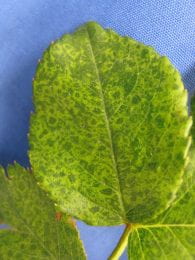Rose Rosette Virus…What does it look like?
By: Judy O’Mara
We’ve had several reports of rose rosette virus in the K-State Plant Disease Diagnostic Lab this spring. It is not hard to identify based on symptoms. Basically, the growth on the plant becomes increasingly deformed. It starts with an individual rose cane that either elongates, or gets bunchy with lots of shoots (witches broom). The foliage can be reddish-purple or green and strappy (see below). Very characteristic for rose rosette virus is the production of excessive thorns along the canes of the deformed shoots. Symptoms on the plant get worse over a few weeks. In an odd way, it can sometimes look like a bridal bouquet.


 Left unchecked rose rosette virus will kill the infected plant and continue to spread to nearby roses via its insect vector (Phyllocoptes fructiphilus), an eriophyid mite. This tiny mite is not visible to the eye, resides in new growth and crevices, and is spread by the wind.
Left unchecked rose rosette virus will kill the infected plant and continue to spread to nearby roses via its insect vector (Phyllocoptes fructiphilus), an eriophyid mite. This tiny mite is not visible to the eye, resides in new growth and crevices, and is spread by the wind.
Pruning out deformed portions of the plant is not an effective control strategy as the disease can overwinter in the roots. Upon seeing symptoms, infected plants should be dug up (including the root ball) bagged, and removed from the site.
For more information on this disease see the K-State fact sheet on rose rosette virus.
Rose Mosaic Virus…How do you spot it?
By: Chandler Day
Have you seen yellow oak leaf or netted patterns on your rose bush leaves? If so, you most likely have a disease called Rose Mosaic Virus. This rose disease is relatively common in Kansas landscapes and symptoms can vary from wavy yellow lines or ring spots to mottled oak leaf and mosaic patterns. Rose Mosaic Virus spreads through vegetative propagation and does NOT move around via insects or mites. Another rose disease, rose rosette virus, will kill the infected rose plants, while rose mosaic virus disease will not. Plants infected with rose mosaic virus will produce symptoms on the rose plant every year for the remainder of its life.


The best ways to prevent viral diseases on your rose bushes are to start by buying non-symptomatic plants that have leafed out, or certified disease-free roses. Symptomatic plants in the landscape should be dug up (with the root ball), bagged and discarded.


Photos by Megan Kennelly/KSU
Rose Garden Observations and Recommendations (Coming Soon)
By: Brooke Garcia
Following an extremely wet spring, I’ve noticed several roses to be impacted by Black Leaf Spot. With continuous rainfall and high humidity, this fungal disease thrives. As this fungal disease develops, you can begin to notice black spots on the leaves. The leaves often times will turn yellow, eventually dropping from the plant. An easy way to spot this on plants (despite seeing the dark black spots and yellowing leaves) is to look at the bottom of the plant. The bottom portion of the rose shrub will most likely look bare, without leaves.


Despite having all of our recent rains, I’ve noticed some roses appear to be performing well given the circumstances. My recommendations are purely coming from an observational standpoint. On the other hand, many of these roses in particular were surrounded by other rose plantings that were impacted by both Black Leaf Spot and Rose Rosette Virus.
Here are the following rose recommendations:
- ‘Honey Perfume’
- ‘Princess Charlene De Monaco’ Hybrid Tea Rose
- ‘Coral Drift’
- ‘Lemon Drift’
- ‘Top Gun’





